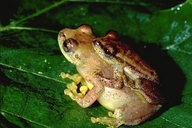|
Hyperolius discodactylus Ahl, 1931
Highland Reed Frog | family: Hyperoliidae genus: Hyperolius |
 © 2004 Robert C. Drewes (1 of 4) |
|
|
|
Description A large Hyperolius (males 29–33 mm) from montane forests in central Africa. Dorsum uniform brownish to orange, uniform or with diffuse dark spots. A dark canthal line. Vocal sac in calling males bright green. Ventrum bright orange. Pupil horizontal (Schiøtz 1999). Hyperolius discodactylus was split from a similar species, Hyperolius alticola. When they were differentiated as separate species, it was for a myriad of reasons, on of them being differences in species among morphological traits such as the interorbital space, tympanum, toe webbing, tibia length, subarticular tubercle, and skin of belly. For the space between its eyes, the difference is in width were that H. discodactylus is two times the width of the top eyelid while H. alticola is 1.5 times as wide as the top eyelid. The tympanum on H. alticola is smaller and free verses hidden under a thin layer of skin on H. discodactylus. The bellies of these species differ in that H. discodactylus has clear postpectoral folds while H. alticola does not. The same is seen with the temporofemoral fold between species. The other morphological differences are in length with slight noticeable variation (Liedtke et al. 2014). In preservative (ethanol): This species dorsum and posterior area below the ribs of this species are a brownish white coloration with darker peppered pigmentation forming a canthal line along its body. Its ventral coloration is a uniform pale yellow (Liedtke et al. 2014).
Distribution and Habitat Country distribution from AmphibiaWeb's database: Burundi, Congo, the Democratic Republic of the, Rwanda, Uganda
Found in high-elevation montane forest along streams in western Rwanda, western Burundi, southwestern Uganda, and eastern D. R. Congo (Channing and Howell 2006).
Life History, Abundance, Activity, and Special Behaviors The call is a rather long buzzing with a duration of about 0.3 sec and a frequency-intensity maximum at about 2000–2500 cps (Schiøtz 1999).
Trends and Threats Although the species was initially listed as "Vulnerable", it is now considered "Least Concern". Threats to this species include agriculture, aquaculture, biological resource use, logging, small holder farming, ranching, and grazing. It also lives in a highly fragmented habitat (IUCN SSC 2013).
Possible reasons for amphibian decline General habitat alteration and loss Comments The specimens described here were very similar to H. frontalis collected nearby (Schiøtz 1999). Initially they were described as H. alticola, but H. discodactylus has priority as the name (Schiøtz 1999; Frost 2007). However, the recent rediscovery of H. alticola has led to the split of the two species again (Liedtke et al. 2014). The two species of reed frogs were first discovered by Ernst Ahl in 1931. He found these species inhibiting the forests of the Albertine Rift in Eastern Africa. The two were synonymized by Raymond Green two decades later but a conclusive decision on this taxonomy was never made because the type material for H. alticola was lost. After the material was recently rediscovered, the validity of Laurent’s synonymy has been under reassessment. Genetic findings suggest a Northern and Southern clade and diverging morphologies also suggest a split between species. Though genetic and morphological differences are marginal, they reflect population level variation thus further supporting the continuation of H. discodactylus and the discontinuation of H. alticola is a valid taxon (Liedtke et al. 2014). The majority of this account was taken from "Treefrogs of Africa" by Arne Schiøtz with kind permission from Edition Chimaira publishers, Frankfurt am Main. The species authority is: Ahl, E. (1931b) Zur Systematik der afrikanischen Artes der Baumfrochgattung Hyperolius. Mitteilungen aus dem Zoologischen Museum in Berlin, 17 (1), 1–132.
References
Channing, A., and Howell, K. M. (2006). Amphibians of East Africa. Cornell University Press, Ithaca. Frost, D. R. (2007). Amphibian Species of the World: an Online Reference. Version 5.1 (10 October 2007). Electronic Database accessible at http://research.amnh.org/herpetology/amphibia/index.php. American Museum of Natural History, New York, USA. Liedtke, H. C., D. Hugli, J. M. Dehling, F. Pupin, M. Menegon, and A. J. Plumptre. ''One or Two Species? On the Case of Hyperolius Discodactylus Ahl, 1931 and H. Alticola Ahl, 1931 (Anura: Hyperoliidae).''Zootaxa 3768.3 (2014): 253-90. Print. Schiøtz, A. (1999). Treefrogs of Africa. Edition Chimaira, Frankfurt am Main. Originally submitted by: A. Beti, Shakil Huq (first posted 2008-03-06) Description by: Michelle S. Koo (updated 2021-03-17)
Life history by: Michelle S. Koo (updated 2021-03-17)
Comments by: Michelle S. Koo (updated 2021-03-17)
Edited by: Ann T. Chang (2021-03-17) Species Account Citation: AmphibiaWeb 2021 Hyperolius discodactylus: Highland Reed Frog <https://amphibiaweb.org/species/523> University of California, Berkeley, CA, USA. Accessed May 21, 2025.
Feedback or comments about this page.
Citation: AmphibiaWeb. 2025. <https://amphibiaweb.org> University of California, Berkeley, CA, USA. Accessed 21 May 2025. AmphibiaWeb's policy on data use. |



 Map of Life
Map of Life